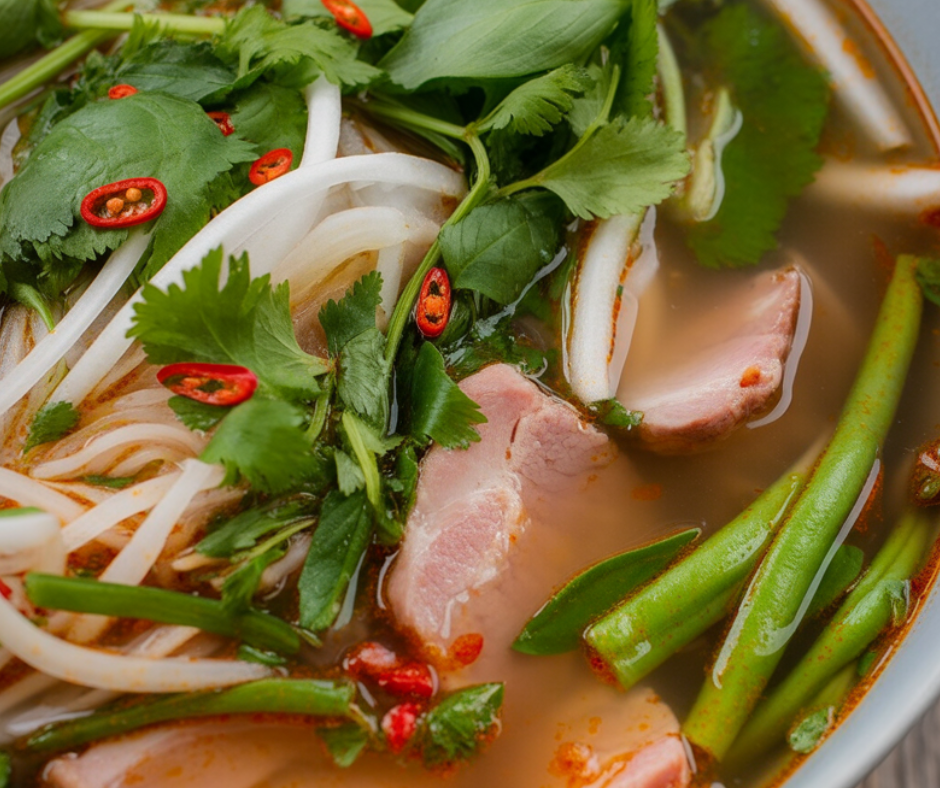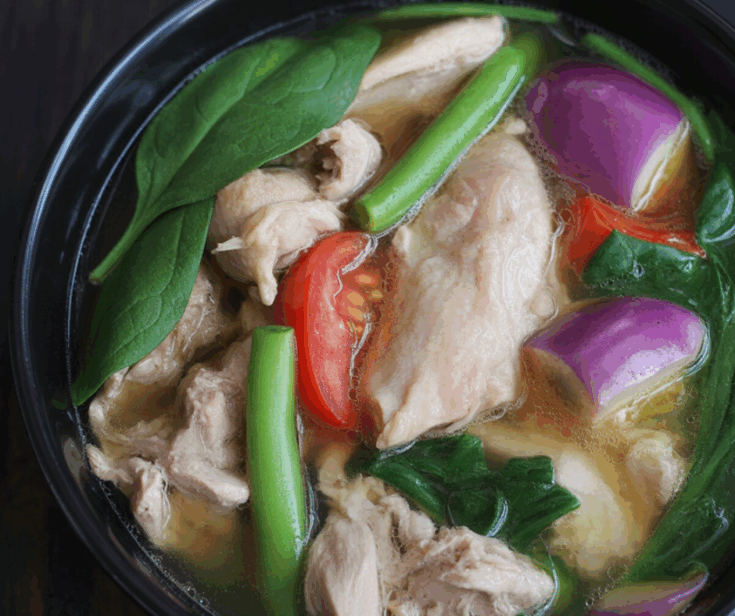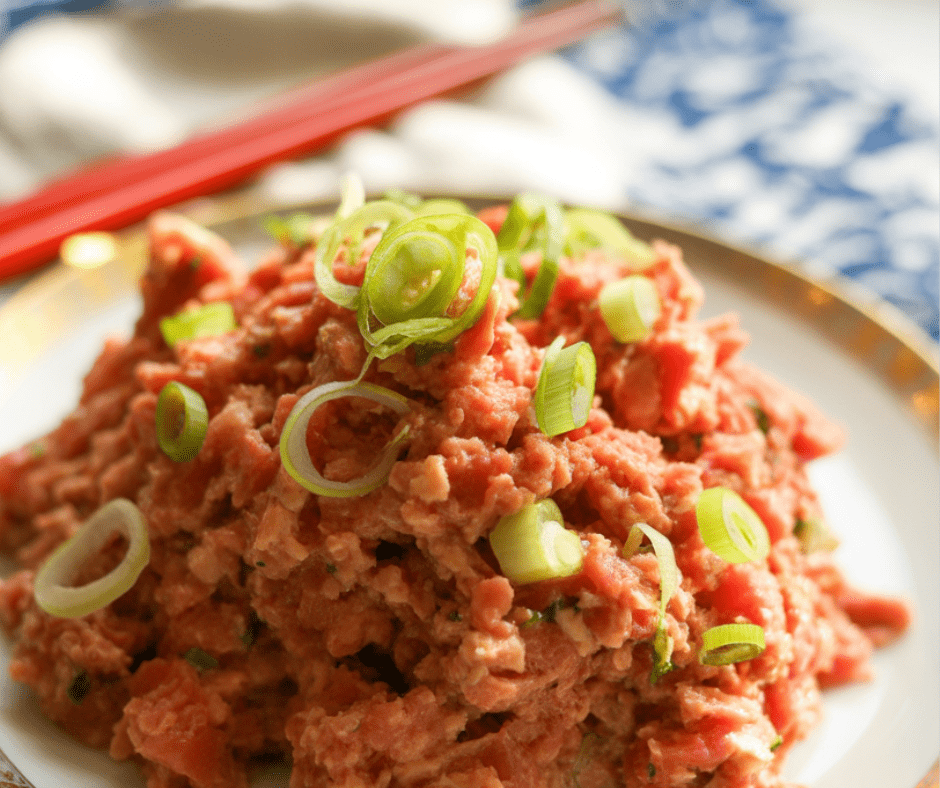If there’s one dish that instantly makes me feel like I’m back home on a rainy day, it’s Pork Sinigang. This Filipino sour soup is rich, tangy, and comforting—made with tender pork belly simmered in a tamarind broth and loaded with fresh veggies. Whether you’re under the weather or just craving something hearty, this bowl hits all the right spots.

A Soup That Tastes Like Home
I grew up with sinigang on the table at least once a week. My mom would serve it with hot rice and a tiny saucer of fish sauce mixed with crushed bird’s eye chilies—it was our ritual. And on stormy evenings? A side of fried tuyo (salted dried fish) made the whole meal extra special. If you’ve never tried that combo, you’re seriously missing out.
What is Sinigang?
Sinigang is a Filipino sour soup that’s equal parts savory and refreshing. Think of it as a warm, tangy stew with meat, vegetables, and loads of comfort. Traditionally made with pork, it’s also commonly cooked with shrimp, fish, or beef. The sourness comes from natural fruits like tamarind, and each spoonful is like a hug for your soul.
Why You’ll Love This Dish
This dish isn’t just tasty—it’s adaptable, nourishing, and full of flavor. You can swap in different proteins like shrimp or fish, load it up with seasonal vegetables, or go the old-school route with fresh tamarind for that authentic sour kick. It’s also perfect for meal prep and reheats like a dream.

Ingredients You’ll Need
For the pork and broth:
- 2 lbs pork belly (or pork with bones like spare ribs or neck bones)
- 2 quarts water (for the tamarind broth)
- 1 large onion, quartered
- 2 tomatoes, halved (add more for later)
- Fish sauce, to taste
- Ground black pepper (optional)
For the souring agent:
- 1 cup fresh young tamarind (or sinigang mix for convenience)
For the vegetables:
- 1 medium daikon radish, peeled and sliced
- 2 Japanese eggplants, sliced diagonally
- 1 bunch string beans (sitaw), cut into 2-inch lengths
- 6 long green chili peppers (siling pangsigang)
- 8–10 okra pods, trimmed
- 1 bunch water spinach (kangkong), separated into stalks and leaves
How to Cook Pork Sinigang
Step 1: Make the Tamarind Broth
Start by boiling the fresh young tamarind in 2 quarts of water for about 40–60 minutes until the water gets that deep sour flavor. Strain out the solids using a sieve, and press the pulp to squeeze out every last drop of flavor. If you’re using sinigang mix, you can skip this and dissolve the powder in water later.
Step 2: Simmer the Pork
Pour the tamarind broth into a large pot. Add your onion and tomato, then drop in the pork belly. Cover and let it come to a boil. Skim off any scum that floats to the top. Add fish sauce for seasoning, cover again, and simmer gently until the pork is fork-tender—this usually takes 45 to 90 minutes depending on the cut.
Step 3: Add Vegetables in Stages
Once the pork is tender, start adding the vegetables. First in: daikon radish and eggplant. If you like your string beans extra soft, you can add them now too. Cook on low for about 5 minutes.
Then toss in the long green chilies, remaining tomatoes, string beans (if not added earlier), and okra. Let these simmer for another 3–4 minutes.
Step 4: Finish with Greens
Add the kangkong stalks first and season the broth again with fish sauce and pepper if needed. After 2 minutes, turn off the heat and toss in the kangkong leaves. Cover the pot and let the residual heat wilt the greens. By the time the rice is ready, so is your sinigang.
What Makes Sinigang Sour?
Sinigang’s magic lies in the sourness, and here are a few fruits traditionally used as souring agents:
- Tamarind (Sampaloc): Most common, deeply tangy, and what gives sinigang its iconic taste.
- Guava: Sweet and tart, gives the broth a softer sour note.
- Bilimbi (Kamias): Super sour and sharp—great for traditional home-style sinigang.
- Green Mango: Adds a clean, fruity tang with a firm texture.
- Pineapple: Balances sweet and sour for a tropical twist.
- Cotton Fruit (Santol): Can be quite tart when unripe, mellows as it ripens.
Where Did Sinigang Come From?
Sinigang is native to the Philippines and gets its name from the word “sigang,” which means “to stew” in Tagalog. Though it’s made across the country, the Tagalog version with tamarind is the most well-known. And yes, even though it’s not officially the national dish (adobo holds that claim unofficially), ask any Filipino and they’ll likely say sinigang is their personal favorite.

Variations to Try
Sinigang isn’t just about pork—you’ve got plenty of delicious options:
- Sinigang na Hipon: With shrimp. Keep the cooking time short so the shrimp doesn’t overcook.
- Sinigang na Bangus: Milkfish is another popular choice, especially in provincial homes.
- Sinigang sa Miso: Add fermented soybean paste for a deeper, umami flavor.
- Sinigang na Inasal: A fusion twist that combines the smoky grilled flavor of chicken inasal with a sinigang broth. Surprisingly good!
Tips for the Best Sinigang
- Choose the right cut of pork: Pork belly or shoulder adds richness thanks to its fat. Meat with bones, like spare ribs, also gives the broth more depth.
- Don’t skip the aromatics: Onion and tomato should be added early for flavor.
- Add vegetables in layers: Start with the ones that take longer to cook, then finish with greens.
- Shortcut? Use sinigang mix, but balance it with fresh tomatoes or tamarind if you want to enhance the flavor.
How to Serve Sinigang
Always serve it hot—ideally steaming—over a plate of white rice. And don’t forget the dipping sauce: fish sauce with fresh chopped Thai chilies adds an extra punch of salt and heat.
How to Store Leftovers
Let the sinigang cool completely before transferring it to an airtight container. It’ll keep in the fridge for up to 3 days. Reheat gently on the stove—avoid overcooking the greens when reheating. You can also freeze it for up to a month, but leave out the kangkong and add fresh greens when reheating.
Sinigang – Filipino Sour Soup Comfort

A tangy Filipino soup made with pork and assorted vegetables
Ingredients
- 2 lbs pork belly (see notes)
- 1 lb young tamarind (see notes)
- 1 bunch water spinach, chopped
- 8 pieces string beans, cut into 2-inch lengths
- 2 eggplants, sliced
- 1 daikon radish (see notes)
- 8 pieces okra
- 2 tomatoes, cut into wedges
- 2 long green peppers
- 1 onion, sliced into wedges
- 2 quarts water
- Fish sauce and ground black pepper, to taste
Instructions
- In a large pot, boil the young tamarind in 2 quarts of water for 40 minutes. Strain the liquid using a sieve or strainer, and press the tamarind to release all the juices.
(Ingredients used: 1 lb young tamarind, 2 quarts water) - Transfer the tamarind broth back to the pot. Bring it to a boil, then add the onion, pork belly, and half of the tomatoes.
(Ingredients used: 2 lbs pork belly, 1 onion, 2 tomatoes) - Skim off any foam or scum that rises to the top. Add 1 tablespoon of fish sauce, cover, and simmer for 1 hour.
(Season with fish sauce and ground black pepper as needed) - Add the daikon radish and sliced eggplants. Cook for about 5 minutes.
(Ingredients used: 1 daikon radish, 2 eggplants) - Next, add the long green peppers, string beans, the rest of the tomatoes, and the okra. Cook for an additional 3 minutes.
(Ingredients used: 2 long green peppers, 8 string beans, 2 tomatoes, 8 okra) - Stir in the chopped stalks of water spinach. Season again with fish sauce and black pepper. Cook for 2 minutes.
(Ingredients used: Fish sauce and black pepper) - Finally, add the water spinach leaves. Cover the pot and turn off the heat. Let the residual heat cook the leaves for around 3 minutes.
(Ingredients used: 1 bunch water spinach) - Serve hot and enjoy!
Notes
- Pork Belly – This cut is ideal for sinigang because its fat content keeps the meat moist and tender. Other suitable cuts include pork shoulder, spare ribs, and neck bones.
- Young Tamarind – For a truly sour flavor, use only young tamarind. You may also mix in ripe tamarind for a touch of sweetness.
- Daikon Radish – Optional, but it adds a pleasant texture and mild flavor.
- Taro (Gabi) – Adding taro makes the broth thicker. This variation is called sinigang na baboy with gabi.
Nutrition Information:
Yield: 4 Serving Size: 1Amount Per Serving: Calories: 1249Total Fat: 52gSaturated Fat: 19gTrans Fat: 0gUnsaturated Fat: 31gCholesterol: 191mgSodium: 674mgCarbohydrates: 142gFiber: 32gSugar: 76gProtein: 71g
Asianplated.com, occasionally offers nutritional information for recipes contained on this site. This information is provided as a courtesy and is an estimate only. This information comes from online calculators. Although allchickenrecipes.com attempts to provide accurate nutritional information, these figures are only estimates.
Frequently Asked Questions
Is sinigang the national dish of the Philippines?
Not officially—adobo usually gets that title—but sinigang is definitely the people’s favorite, especially during cozy family meals.
Can I use spinach instead of kangkong?
Yes, spinach is a great substitute if you can’t find water spinach. Add it at the very end so it doesn’t overcook.
Can I make it vegetarian?
Absolutely. Use mushrooms, tofu, and a hearty mix of vegetables. For the broth, just use tamarind and aromatics—no meat needed.
What if I don’t have all the veggies?
No worries! As long as you have pork, a souring agent, and leafy greens, you can make a great bowl of sinigang.
If you’ve never tried sinigang before, this is your sign. It’s warm, sour, and full of flavor—exactly the kind of dish you’ll keep coming back to. Cook it once, and I bet it becomes part of your regular rotation. Let me know how it turns out for you!
Try other filipino recipes:


















